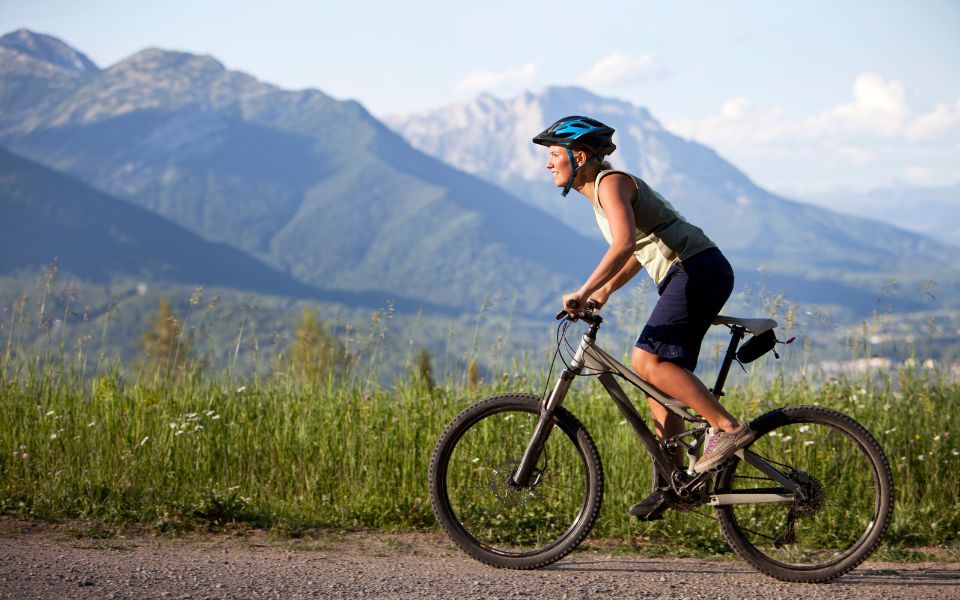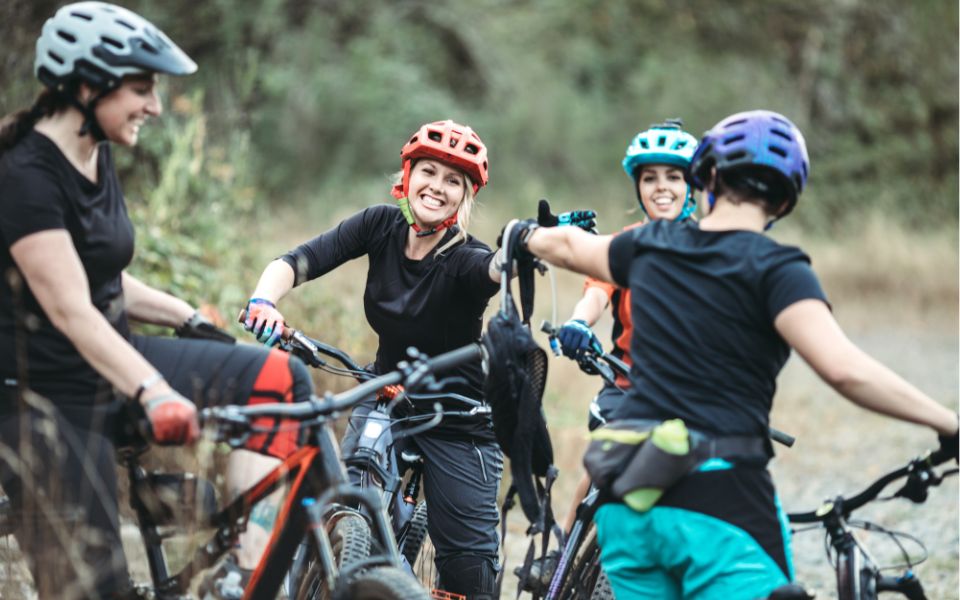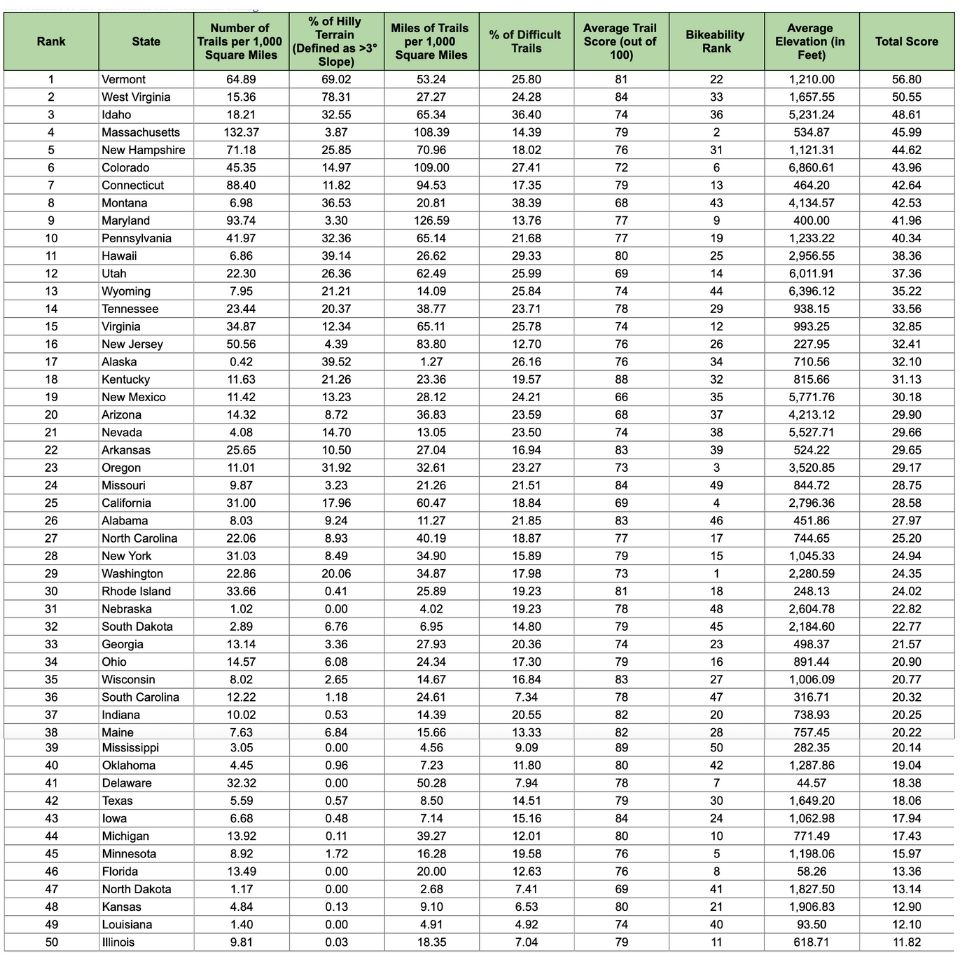Every mountain biker knows the ride isn’t just about the trail. It’s about the place, the conditions, the climb, the flow, and the feeling you get when it all just clicks. But not every state offers that perfect combination. Some have plenty of trails but lack variety while others might have challenging climbs but limited options for flow.

To find the best states for mountain biking, the research team at VelociRAX, a company that sells bike racks, analyzed seven key factors that shape the riding experience. These included the number of trails, percentage of hilly terrain, miles of trails, share of difficult trails, average trail scores, bikeability rankings, and average elevation.
Vermont tops the list for mountain biking with a solid balance of factors. It has 64.89 trails per 1,000 square miles and nearly 70% hilly terrain. The state offers 53.24 miles of trails per 1,000 square miles, with over a quarter marked as difficult. Vermont’s trails score well on average, and its moderate elevation of 1,210 feet adds to a varied riding experience.
West Virginia comes in second, known for its very hilly landscape, with 78% of its terrain having slopes over 3 degrees. It has fewer trails per area than Vermont but still offers 27.27 miles of trails per 1,000 square miles. About 24% of these trails are difficult, making it a good spot for riders looking for a challenge.
Idaho ranks third, standing out with its high average elevation of over 5,200 feet. It has fewer trails per square mile but offers the highest percentage of difficult trails at 36.4%. With 65.34 miles of trails per 1,000 square miles and a solid average trail score, Idaho appeals to more experienced mountain bikers.
Massachusetts is fourth, with the highest number of trails per 1,000 square miles at 132.37 and over 108 miles of trails in the same area. Its terrain is mostly flat, with less than 4% hilly land and only about 14% difficult trails. Despite this, Massachusetts ranks high because of its extensive and accessible trail network.

New Hampshire holds the fifth spot with 71.18 trails per 1,000 square miles and a moderate 26% of hilly terrain. It offers nearly 71 miles of trails per 1,000 square miles and has about 18% difficult trails. Its elevation is similar to Vermont, making it a good mix of terrain and trail variety.
Colorado is sixth, famous for its high mountains and outdoor sports. It has fewer trails per area but offers over 109 miles of trails per 1,000 square miles. Its terrain is less hilly than some others at 15%, but it has a good percentage of difficult trails at 27%. Colorado’s high average elevation of nearly 6,900 feet adds to its appeal for riders seeking altitude and challenge.
Connecticut is seventh, with 88.4 trails per 1,000 square miles and almost 95 miles of trails in that area. It has mostly flat terrain with only about 12% hilly land and 17% difficult trails. Connecticut’s bikeability rank is strong, making it friendly for riders looking for well-maintained and accessible trails.
Montana ranks eighth with fewer trails at about 7 per 1,000 square miles but a decent 36.5% hilly terrain. It offers fewer miles of trails per area but has the highest percentage of difficult trails along with Idaho, at 38.4%. Its high elevation of over 4,100 feet adds to its rugged mountain biking options.
Maryland is ninth, with 93.74 trails per 1,000 square miles and the highest miles of trails at 126.59. Its terrain is mostly flat, only about 3.3% hilly, and it has fewer difficult trails at around 14%. Maryland’s lower elevation and extensive trail network make it a good choice for riders who prefer easier terrain but want variety.
Pennsylvania rounds out the top ten. It has 42 trails per 1,000 square miles and 32% hilly terrain. It offers 65.14 miles of trails per 1,000 square miles, with just over 21% marked as difficult. Pennsylvania’s mix of terrain and trails offers a solid option for riders who want both challenge and variety.

Methodology
This study ranked U.S. states for mountain biking by evaluating seven key factors that influence the quality and challenge of the riding experience. Each factor was assigned a specific weight based on its importance to mountain bikers, and data was collected for all 50 states. The factors were scored on a scale from 0 to 100, with higher scores representing better mountain biking conditions.
Here are the factors, along with their respective weights:
Source
MTB Project
USDA Economic Research Service
Trailforks
League of American Bicyclists
The Women's Outdoor News, aka The WON, features news, reviews and stories about women who are shooting, hunting, fishing and actively engaging in outdoor adventure. This publication is for women, by women. View all posts by The WON